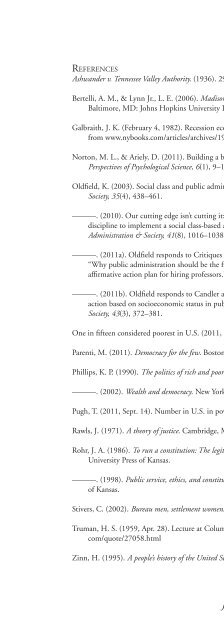WINTER 2012 - National Association of Schools of Public Affairs and ...
WINTER 2012 - National Association of Schools of Public Affairs and ...
WINTER 2012 - National Association of Schools of Public Affairs and ...
Create successful ePaper yourself
Turn your PDF publications into a flip-book with our unique Google optimized e-Paper software.
Pamela A. Gibson <strong>and</strong> Pamela Trump Dunning<br />
objectives; (b) remaining student-centered in the specific elements needing to<br />
include in the course design; <strong>and</strong> (c) creating mechanisms to ensure that students<br />
have multiple opportunities to perform <strong>and</strong> receive feedback, engage with one<br />
another <strong>and</strong> the instructor, <strong>and</strong> track their successful progression through the<br />
course objectives.<br />
The improvement <strong>of</strong> course designs occurred in three prominent arenas:<br />
the establishment <strong>of</strong> st<strong>and</strong>ards whereby learning objectives, method <strong>and</strong> type<br />
<strong>of</strong> instruction, <strong>and</strong> assessment <strong>of</strong> student performance are linked; the creation<br />
<strong>of</strong> interactive functions to produce a “community” in which learning can most<br />
actively occur; <strong>and</strong> the construction <strong>of</strong> quantifiable actions required from the<br />
class participants.<br />
Although these objectives are certainly applicable to the improvement <strong>of</strong> all<br />
instructional formats, a more varied method <strong>and</strong> type <strong>of</strong> instruction was required<br />
in creating a virtual community online, where more diverse demonstrations<br />
<strong>of</strong> learning are occurring than would be seen in a traditional classroom<br />
environment. The following subsections represent instructional design criteria<br />
incorporated into both the syllabi <strong>and</strong> the Bb course shells as a result <strong>of</strong> the<br />
QM assessment.<br />
Alignment <strong>of</strong> St<strong>and</strong>ards<br />
The link must be made between learning objectives, the tools by which<br />
information is transmitted, <strong>and</strong> the assessment or measurement by which it<br />
is determined that students met the objectives (Chaney et al., 2007; Killian,<br />
2004). These key components comprise the st<strong>and</strong>ards for assessing course design<br />
quality. Alignment among them is crucial. When aligned, each course element is<br />
directly tied to <strong>and</strong> supports the learning objectives, thus ensuring students meet<br />
the desired learning outcomes.<br />
The learning objectives need to describe outcomes that are measurable as<br />
well as specific to the individual module <strong>of</strong> learning (Koszalka & Ganesan,<br />
2004). The learning activities that an instructor develops should align with<br />
these objectives <strong>and</strong> facilitate the student’s achievement <strong>of</strong> them. The MPA<br />
program has adopted a course design matrix that is a required part <strong>of</strong> the course<br />
syllabus for courses in which any part is <strong>of</strong>fered online. The matrix links each<br />
course learning objective to a module <strong>of</strong> instruction, the specific course content,<br />
the learning strategy, <strong>and</strong> the assessment mechanism (see Appendix B for<br />
instructions <strong>and</strong> an example).<br />
Although the template is the same for all courses with an online component,<br />
instructors are required to adapt it to their individual course. Also, while this<br />
alignment strategy can be considered a key part <strong>of</strong> course design in both a<br />
traditional <strong>and</strong> an online course, the online environment affords additional<br />
opportunities in course design to demonstrate these essential linkages.<br />
Development <strong>of</strong> the matrix was found to be the most important <strong>and</strong> most<br />
214 Journal <strong>of</strong> <strong>Public</strong> <strong>Affairs</strong> Education

















